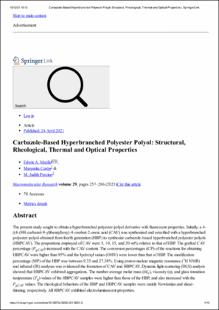Carbazole-Based Hyperbranched Polyester Polyol: Structural, Rheological, Thermal and Optical Properties
...
Murillo, Edwin A. | 2021-04-24
The present study sought to obtain a hyperbranched polyester polyol derivative with fluorescent properties. Initially, a 4-((4-(9H-carbazol-9-yl)benzyl)oxy)-4-oxobut-2-enoic acid (CAV) was synthesized and esterified with a hyperbranched polyester polyol obtained from fourth generation (HBP) to synthesize carbazole-based hyperbranched polyester polyols (HBPCAV). The proportions employed of CAV were 5, 10, 15, and 20 wt% relative to that of HBP. The grafted CAV percentage (PgCAV) increased with the CAV content. The conversion percentages (CP) of the reactions for obtaining HBPCAV were higher than 95% and the hydroxyl values (OHV) were lower than that of HBP. The modification percentage (MP) of the HBP was between 9.33 and 27.38%. Using proton nuclear magnetic resonance (1H NMR) and infrared (IR) analyses was evidenced the formation of CAV and HBPCAV. Dynamic light scattering (DLS) analysis showed that HBPCAV exhibited aggregations. The number average molar mass (Mn), viscosity (η), and glass transition temperature (Tg) values of the HBPCAV samples were higher than those of the HBP, and also increased with the PgCAV values. The rheological behaviors of the HBP and HBPCAV samples were mainly Newtonian and shear-thinning, respectively. All HBPCAV exhibited electroluminescent properties.
LEER










